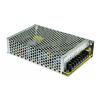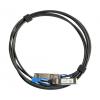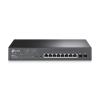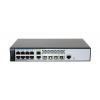-
zł
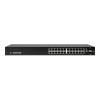
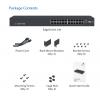
EdgeSwitch 24-Lite to zarządzalny przełącznik firmy Ubiquiti. Wyposażony jest w 24 gigabitowe porty Ethernet oraz 2 sloty na wkładki SFP. Posiada funkcjonalność przełącznika Layer2 oraz możliwość routingu Layer3 (tylko routing statyczny i policy-based). Przystosowany jest do wykorzystania w sieciach o dużej przepustowości, oferuje wysoką wydajność i liczne funkcje zarządzania. Posiada wbudowany zasilacz, może być zasilany bezpośrednio z gniazdka, wyposażony został również we wtyk DC (16 - 25 V, 56 W, wtyk 2,5 mm). Dwa źródła zasilania mogą pracować redundantnie.
Łączna przepustowość (non-blocking) wynosi 26 Gb/s, przepustowość przełączania 52 Gb/s, a prędkość przekazywania 38,69 Mpps. Urządzenie oferuje m. in. takie funkcje jak: MSTP / RSTP / STP, VLAN, Private VLAN, Voice VLAN, Link Aggregation, DHCP Snooping, IGMP Snooping, DiffServ, serwer DHCP i wiele innych. Zarządzanie odbywa się z poziomu graficznego interfejsu lub linii komend CLI (dostępnej poprzez port konsoli, telnet lub SSH).
Przełącznik posiada obudowę przystosowaną do montażu w szafie Rack 19", uszy znajdują się w zestawie.
Najważniejsze cechy:
- 24 gigabitowe porty Ethernet;
- 2 sloty na wkładki SFP;
- łączna przepustowość (non-blocking) 26 Gb/s;
- przepustowość przełączania 52 Gb/s;
- prędkość przekazywania: 38,69 Mpps;
- zarządzanie z poziomu graficznego interfejsu lub CLI;
- dwa źródła zasilania (mogą pracować redundantnie);
- obudowa przystosowana do montażu w szafie Rack.
Specyfikacja:
| ES-24-Lite | |
| Łączna przepustowość | 26 Gb/s |
| Przepustowość przełączania | 52 Gb/s |
| Prędkość przekazywania | 38,69 Mpps |
| Maksymalny pobór mocy | 25 W |
| Sposób zasilania |
AC: 100 - 240 V AC / 50 - 60 Hz DC: 16 - 25 V, 25 W (wtyk DC 2,5 mm) |
| Zasilacz | Wbudowany |
| Diody LED na port |
Konsola: Brak RJ45: Speed / Link / Activity SFP: Speed / Link / Activity |
| Interfejs sieciowy |
24x gigabitowy ort Ethernet 10/100/1000 Mb/s 2x SFP |
| Interfejs zarządzania |
1x port RJ45 Ethernet In/Out Band |
| Wymiary | 443x43x221 mm |
| Waga | 2,6 kg |
| Możliwość montażu w szafie Rack | Tak, wysokość 1U |
| Certyfikaty | CE, FCC, IC |
| Ochrona ESD/EMP | 24 kV |
| Dopuszczalna temperatura pracy | Od -5 do 40 st. C |
| Dopuszczalna wilgotność powietrza | 5%-95% niekondensująca |
| Wstrząsy i wibracje | ETSI300-019-1.4 |
| Oprogramowanie | |
|---|---|
| Główne funkcje przełączania |
ANSI / TIA-1057: LLDP-Media Endpoint Discovery (MED) IEEE 802.1AB: Link Layer Discovery Protocol (LLDP) IEEE 802.1D: Spanning Tree Compatibility IEEE 802.1S: Multiple Spanning Tree Compatibility IEEE 802.1W: Rapid Spanning Tree Compatibility IEEE 802.1Q: Virtual LANs with Port-Based VLANs IEEE 802.1p: Ethernet Priority with User Provisioning and Mapping IEEE 802.1X: Port-Based Authentication with Guest VLAN Support IEEE 802.3: 10BASE-T IEEE 802.3u: 100BASE-T IEEE 802.3ab: 1000BASE-T IEEE 802.1ak: Virtual Bridged Local Area Networks - Amendment 07: Multiple Registration Protocol IEEE 802.3ac: VLAN Tagging IEEE 802.3ad: Link Aggregation IEEE 802.3x: Flow Control IEEE 802.1D-2004: Generic Attribute Registration Protocol: Clause 12 (GARP) IEEE 802.1D-2004: Dynamic L2 multicast registration: Claue 10 (GMRP) IEEE 802.1Q-2003: Dynamic VLAN registration: Clause 11,2 (GVRP) RFC 4541: considerations for Internet Group Management Procotl (IGMP) Snooping switches RFC 5171: Unidirectional Link Detection (UDLD) Protocol |
| Zaawansowane funkcje Layer2 |
Broadcast storm recovery Broadcast / multicast / unknow unicast storm recovery DHCP Snooping IGMP Snooping Querier Independent VLAN Learning (IVL) Jumbo Ethernet Frame Port MAC Locking Port Mirroring Protected Ports Static MAC Filtering TACACS+ Voice VLANs Unauthenticated VLAN Internal 802.1X Authentication Server |
| Specyfikacja platformy |
DHCP Server:
Routing:
VLANs: 255 MAC Addresses: 8k MSTp Instances: 4 LAGs: 6 ACLs: 100 with 10 rules per port Traffic Classes (queues): 8 |
| Funkcje systemowe |
Event and Error Loggign Facility Run-Time and configuration download capability PING Utility FTP/TFTP trasfers via IPv4/IPv6 Malicious Code Detection BootP and DHCP RFC 2021: Remote Network Monitoring Management Information Base Version 2 RFC 2030: Simple Network Time Protocol (SNTP) RFC 2819: Remote Network Monitoring Management Information Base RFC 2865: RADIUS Client RFC 2866: RADIUS Accounting RFC 2868: RADIUS Attributes for Tunnel Protocol Support RFC 2869: RADIUS Extensions RFC 3579: RADIUS Support for EAP RFC 3580: IEEE 802.1X RADIUS Usage Guidelines RFC 3164: BSD Syslog Protocol |
| Zarządzanie |
Web UI Industry-Standard CLI IPv6 Management Password Management Autoinstall Support for Firmware Images and Configuration Files SNMP v1, v2 and v3 SSH 1.5 and 2.0 SSL 3.0 and TLS 1.0 Secure Copy (SCP) Telnet (Multi-Session Support) |
| Routing Layer3 |
Static routing Policy based routing |
| QoS |
Access Control Lists (ACLs), Permi/Deny actions for ibound IP and Layer2 traffic classification based on:
Optional ACL rule attributes:
Differentiated Services (DiffServ):
Class of Service (CoS) queue mapping configuration:
|






 Polski
Polski English
English Italiano
Italiano Español
Español Čeština
Čeština Српски
Српски Deutsch
Deutsch Ελληνικά
Ελληνικά Slovenský
Slovenský

